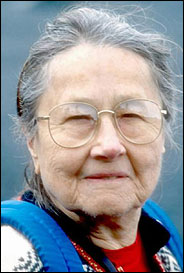Frederica de Laguna
| Frederica Annis Lopez de Leo de Laguna | |
|---|---|

Frederica de Laguna in 1993.
|
|
| Born |
October 3, 1906 Ann Arbor, Michigan |
| Died | October 4, 2004 (aged 98) Haverford, Pennsylvania |
| Other names | Freddy |
| Citizenship | American |
| Fields | anthropology, archaeology, ethnology |
| Institutions | Bryn Mawr College |
| Alma mater | Phoebe Anne Thorne School, Bryn Mawr College, Columbia University |
| Thesis | "A Comparison of Eskimo and Palaeolithic Art" (1933) |
| Known for | Under Mount Saint Elias: The History and Culture of the Yakutat Tlingit |
Frederica ("Freddy") Annis Lopez de Leo de Laguna (October 3, 1906 – October 6, 2004) was an American ethnologist, anthropologist, and archaeologist influential for her work on Paleoindian and Alaska Native art and archaeology in the American northwest and Alaska.
She founded and chaired the anthropology department at Bryn Mawr College from 1938 to 1972 and served as vice-president of the Society for American Archaeology (SAA) from 1949 to 1950 and as president of the American Anthropological Association (AAA) from 1966 to 1967. de Laguna's honors include Bryn Mawr College's Lindback Award for Distinguished Teaching in 1972; her election into the National Academy of Sciences as the first woman, with former classmate Margaret Mead, in 1976; the Distinguished Service Award from the AAA in 1986; a potlatch from the people of Yakutat in 1996; and the Lucy Wharton Drexel Medal from the University of Pennsylvania in 1999.
de Laguna was born to Theodore Lopez de Leo de Laguna and Grace Mead Andrus, philosophy professors at Bryn Mawr College, on October 3, 1906 in Ann Arbor, Michigan. She was home-schooled by her parents until age 9 due to frequent illness. She joined her parents and younger brother Wallace on two sabbaticals during her adolescence: Cambridge and Oxford, England in 1914-1915 and France in 1921-1922.
de Laguna attended Bryn Mawr College on a scholarship from 1923 to 1927, graduating summa cum laude with a degree in politics and economics. Although she was awarded the college's European fellowship, she deferred for a year to study anthropology at Columbia University under Franz Boas, Gladys Reichard, and Ruth Benedict. In 1928, de Laguna traveled to England, France, and Spain, where she gained fieldwork experience under George Grant MacCurdy; "attended lectures on prehistoric art by Abbe Breuil, and received guidance from Paul Rivet and Marcelin Boule." In June, 1929, de Laguna sailed to Greenland as Therkel Mathiassen's assistant on the country's "first scientific archaeological excavation." Staying a total of six months, the excavation convinced her of a future in anthropology and later became the subject of Voyage to Greenland: A Personal Initiation into Anthropology (1997).
...
Wikipedia
